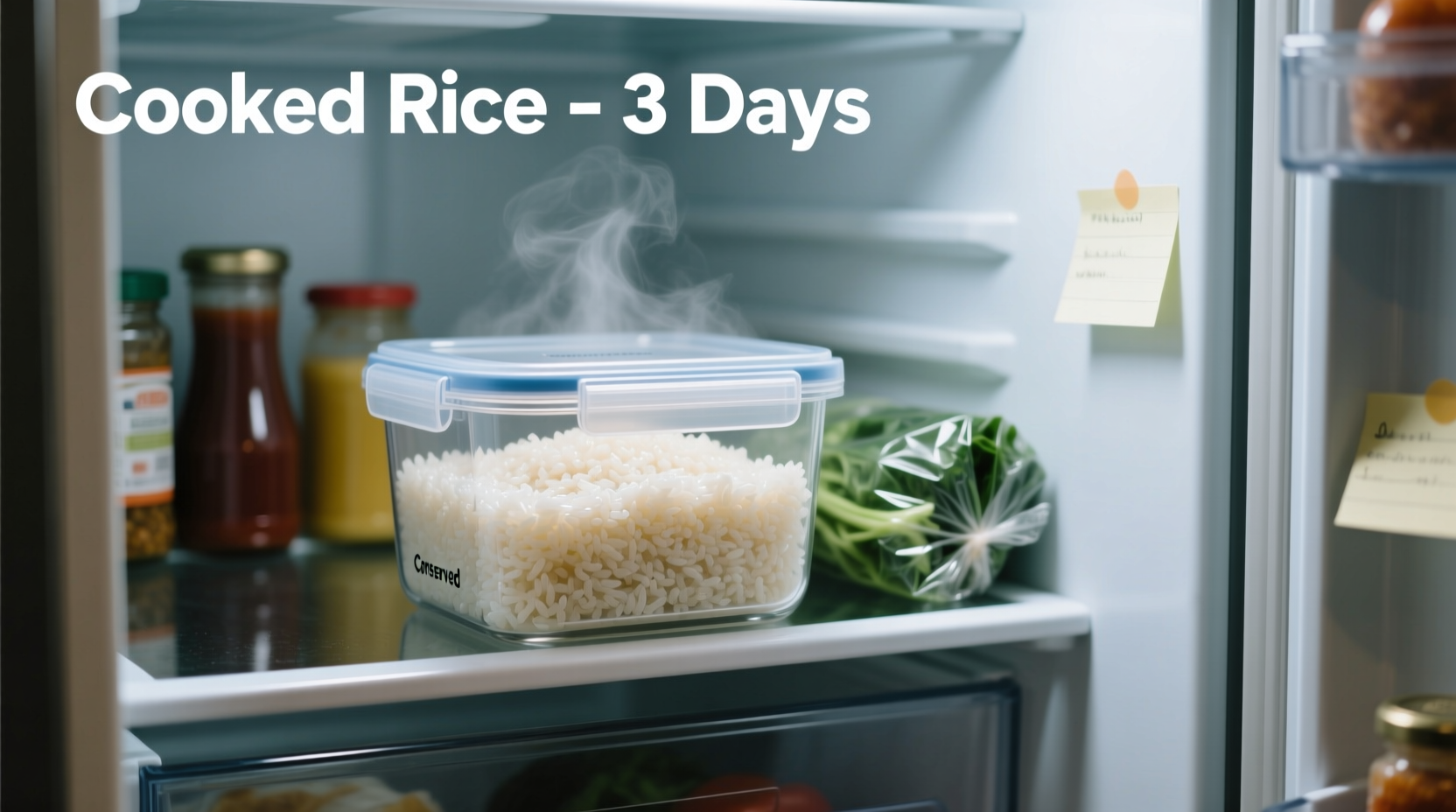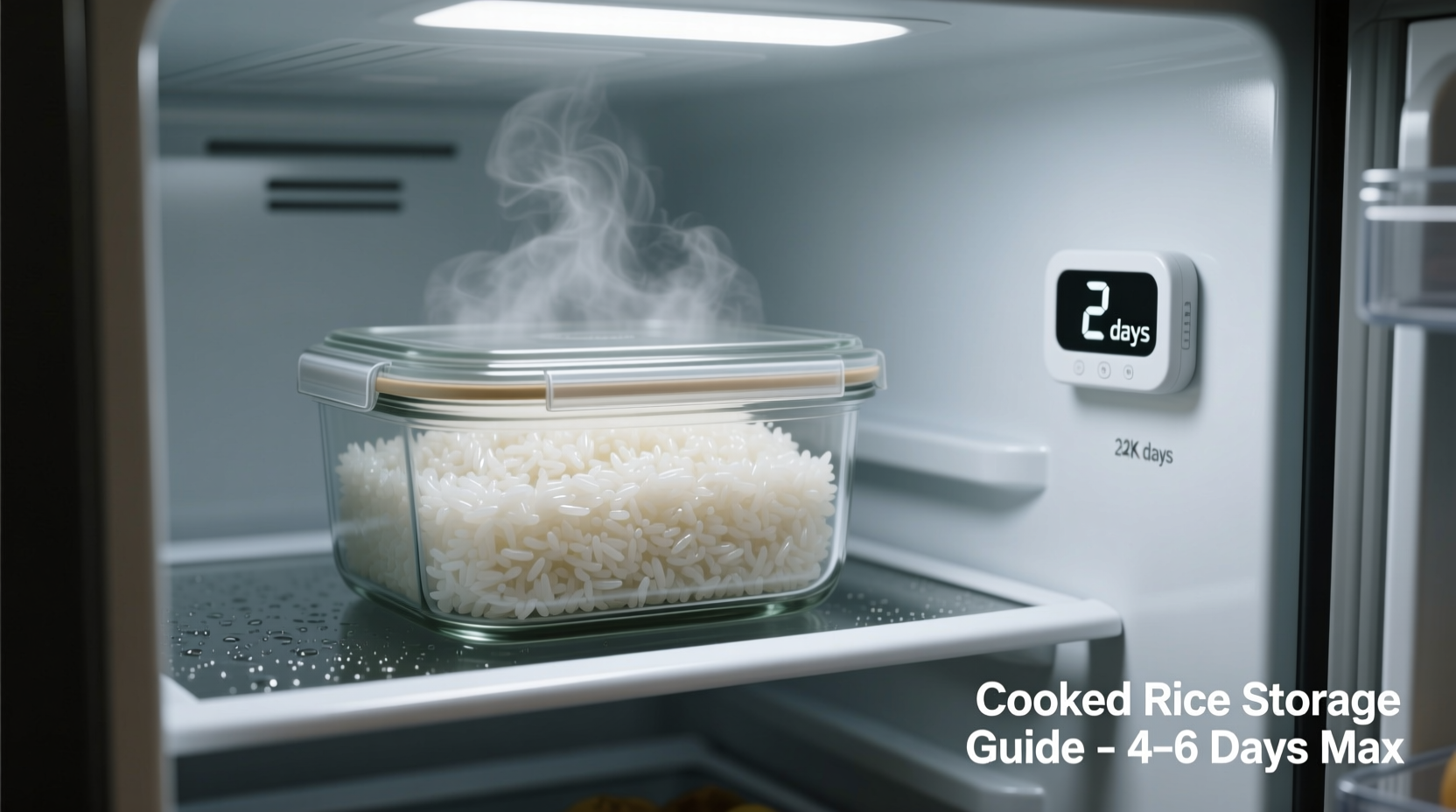Understanding how long cooked rice remains safe in your refrigerator isn't just about avoiding waste—it's critical food safety knowledge. Improperly stored rice can harbor Bacillus cereus, a bacteria that produces toxins causing food poisoning even after reheating. Let's explore exactly how to handle leftover rice safely while maximizing its shelf life.
The Critical First Hour: Cooling Rice Properly
What happens immediately after cooking determines your rice's entire shelf life. The USDA Food Safety and Inspection Service emphasizes that cooked rice must cool from 140°F to 70°F within 2 hours, and from 70°F to 40°F within an additional 2 hours. However, for rice specifically, we recommend a more aggressive cooling timeline due to its unique food safety risks.
Rice Cooling Timeline for Maximum Safety
- 0-30 minutes after cooking: Spread rice in a thin layer on a clean baking sheet—never leave it sitting in the cooking pot
- 30-60 minutes: Rice should reach room temperature; stir occasionally to release trapped heat
- 60 minutes: Transfer to airtight containers and refrigerate immediately
"Rice provides an ideal environment for Bacillus cereus spores to germinate and multiply," explains Dr. Benjamin Chapman, food safety specialist at North Carolina State University. "The danger zone between 40°F and 140°F allows rapid bacterial growth, making proper cooling non-negotiable."
Refrigeration Storage Guidelines by Rice Type
While the standard 3-4 day rule applies to most cooked rice varieties, certain types have slightly different storage considerations. This comparison helps you optimize storage based on your specific rice:
| Rice Type | Max Refrigerator Storage | Special Storage Considerations |
|---|---|---|
| White rice | 4 days | Most vulnerable to moisture loss; store with damp paper towel |
| Brown rice | 3 days | Higher oil content accelerates spoilage; check for rancidity |
| Wild rice | 4 days | Less prone to bacterial growth but watch for mold |
| Rice pilaf or seasoned rice | 3 days | Dairy or egg ingredients reduce shelf life |
Spotting Spoiled Rice: Beyond the Clock
While the 3-4 day rule provides a safe guideline, always check for these spoilage indicators regardless of storage duration:
- Visual changes: Discoloration, mold spots, or excessive dryness
- Texture issues: Unusual stickiness or slimy film on surface
- Smell test: Sour, fermented, or "off" odors (fresh rice has neutral or slightly sweet aroma)
- Tactile warning: Grain clumping that doesn't separate when stirred
When in doubt, throw it out. The USDA's FoodKeeper app confirms that rice showing any spoilage signs should be discarded immediately, regardless of storage time.
Extending Rice Shelf Life: Freezing Techniques
For longer storage, freezing is your best option. Properly frozen rice maintains quality for 6-8 months:
- Cool rice completely using the rapid cooling method described earlier
- Portion into single-serving sizes using freezer bags or containers
- Remove excess air to prevent freezer burn
- Label with contents and date
- Freeze at 0°F (-18°C) or below
For best results when freezing, add one teaspoon of oil per cup of rice before freezing to maintain texture. University of Nebraska-Lincoln Extension research shows this simple step significantly improves thawed rice quality.
Safe Reheating Practices That Matter
Proper reheating is just as crucial as proper storage. Follow these evidence-based reheating guidelines:
- Always add 1-2 tablespoons of water per cup of rice before reheating
- Heat to internal temperature of 165°F (74°C) minimum
- Stir frequently for even heating
- Consume immediately after reheating—don't re-refrigerate
The FDA Food Code specifies that reheated food must reach 165°F within 2 hours to prevent bacterial regrowth. Use a food thermometer to verify temperature, especially when reheating larger portions.
Special Considerations for High-Risk Situations
Certain scenarios require stricter guidelines. The CDC recommends reducing storage time to 2 days when:
- Preparing food for infants, elderly, or immunocompromised individuals
- Rice has been transported (like in lunchboxes or potlucks)
- Using rice cooked with dairy, eggs, or meat ingredients
- During power outages when refrigerator temperature may have fluctuated
"Leftover rice safety is particularly important in childcare settings," notes the American Academy of Pediatrics. "Rice dishes should never be served more than 24 hours after preparation in school or daycare environments."

Maximizing Rice Freshness: Pro Tips
Professional kitchens use these techniques to maintain rice quality throughout service:
- Container selection: Glass containers maintain temperature better than plastic
- Moisture control: Place a damp paper towel over rice before sealing container
- Refrigerator placement: Store in main compartment, not the door where temperatures fluctuate
- First-in-first-out system: Label containers with cooking time for easy rotation
Remember that "how long cooked rice keeps in refrigerator" depends on your specific refrigerator's performance. Use an appliance thermometer to verify your fridge maintains 40°F or below—many home refrigerators run warmer than their settings suggest.
When Leftover Rice Becomes Unsafe
Understanding the science behind rice spoilage helps you make informed decisions. The primary risk comes from Bacillus cereus, which:
- Survives the cooking process as dormant spores
- Germinates and multiplies rapidly between 40°F-140°F
- Produces heat-stable toxins that aren't destroyed by reheating
- Causes vomiting (within 1-5 hours) or diarrhea (6-15 hours after consumption)
The European Food Safety Authority reports that rice left at room temperature for more than 2 hours has a significantly higher risk of containing dangerous toxin levels, regardless of subsequent refrigeration.
Practical Rice Storage Checklist
Follow this simple routine for safe rice storage every time:
- Cook only what you'll eat immediately when possible
- Cool rapidly using the 1-hour rule
- Store in shallow containers no deeper than 2 inches
- Refrigerate within 60 minutes of cooking
- Label with date and time
- Consume within 3-4 days
- Reheat to 165°F with added moisture
Frequently Asked Questions
Can you eat cooked rice after 5 days in the refrigerator?
No, cooked rice should not be consumed after 5 days in the refrigerator. The USDA Food Safety and Inspection Service specifies a maximum 4-day storage period for cooked rice. After this timeframe, even if the rice shows no visible signs of spoilage, it may contain dangerous levels of Bacillus cereus toxins that cause food poisoning.
Why does rice go bad faster than other cooked grains?
Rice has a unique food safety risk because its structure allows Bacillus cereus spores to survive cooking and become active during cooling. Unlike many other grains, rice's starch composition creates an ideal environment for bacterial growth when temperatures drop below 140°F. This makes proper cooling within 1 hour critical for rice but less urgent for grains like quinoa or barley.
What's the safest way to reheat leftover rice?
The safest reheating method involves adding 1-2 tablespoons of water per cup of rice, covering, and heating on medium-low until the internal temperature reaches 165°F (74°C). Stir frequently for even heating. Microwave reheating works well when covered with a damp paper towel. Never reheat rice multiple times, and consume immediately after reheating to prevent bacterial regrowth.
Does adding vinegar or lemon juice extend cooked rice's shelf life?
No, adding acidic ingredients does not significantly extend cooked rice's safe storage time. While acids can slow some bacterial growth, they don't prevent Bacillus cereus toxin production. The USDA confirms that acidified rice still requires the standard 3-4 day refrigeration limit. For longer storage, freezing remains the only safe option regardless of added ingredients.











 浙公网安备
33010002000092号
浙公网安备
33010002000092号 浙B2-20120091-4
浙B2-20120091-4